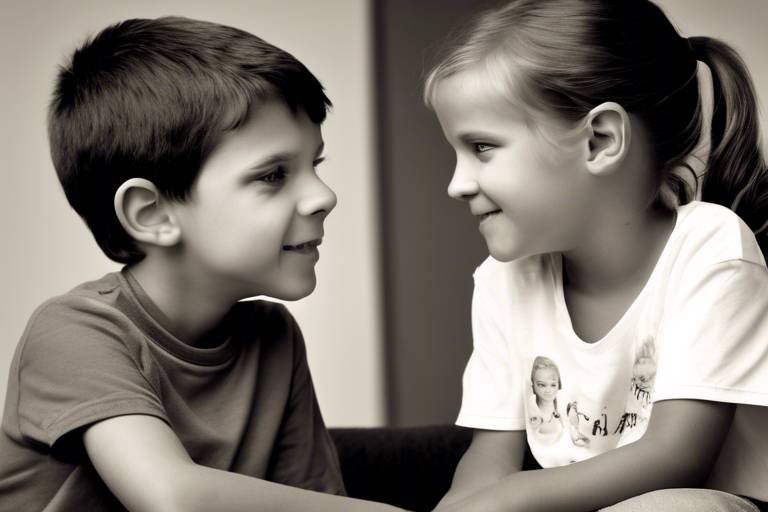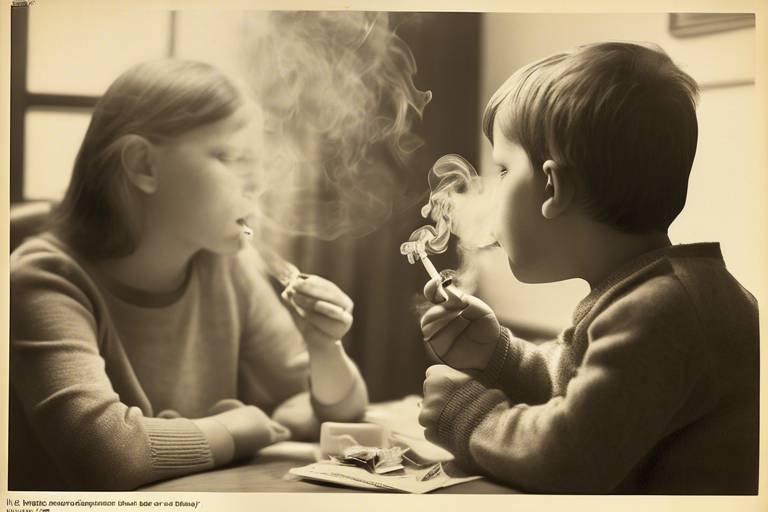Instilling Good Manners in Kids: A Family Affair
Teaching children good manners is more than just a task; it's a family affair that shapes their future interactions and relationships. It’s like planting a seed in a garden—if nurtured properly, it will grow into something beautiful. Good manners serve as the foundation for social skills, self-confidence, and positive interactions with others. Just think about it: when kids say "please" and "thank you," they are not only being polite; they are also learning the art of respect and empathy. These skills are crucial in building their character and navigating the world around them.
As parents, we often wonder how to effectively instill these values in our children. The truth is, it starts with us—our actions, our words, and how we interact with others. Kids are like little sponges, absorbing everything they see and hear. So, if we want them to grow up to be respectful, kind individuals, we need to exemplify those traits ourselves. It’s essential to understand that teaching manners isn't a one-time event; it’s an ongoing process that requires patience, consistency, and creativity.
Moreover, the role of family in teaching manners cannot be overstated. Family is the first social group children encounter, and it plays a pivotal role in shaping their understanding of acceptable behavior. When parents and siblings practice good manners together, children are more likely to adopt those behaviors naturally. It's like a team sport—everyone needs to play their part for the team to succeed. Whether it’s saying hello to neighbors, sharing toys, or waiting their turn, these everyday scenarios provide invaluable lessons that stick with kids for a lifetime.
As we embark on this journey of instilling good manners, let’s remember that it should be a fun and engaging process. After all, teaching kids about respect and kindness doesn’t have to be a chore; it can be an exciting adventure for the whole family. So, let’s roll up our sleeves and dive into practical strategies that can help us cultivate respectful behavior in our little ones!
Understanding why good manners are essential for children helps parents instill these values effectively. Manners contribute to social skills, self-confidence, and positive interactions with others.
Children often mimic the behavior of their parents and siblings. Highlighting the significance of family as role models can encourage children to adopt good manners naturally.
Demonstrating polite behavior in everyday situations teaches children the importance of manners. Parents should strive to showcase respectful interactions in various contexts.
Using daily interactions, like greetings and table manners, provides practical lessons for children. These scenarios help reinforce the importance of politeness in real-life situations.
Acknowledging and praising children when they display good manners encourages them to continue practicing respectful behavior. Positive reinforcement can significantly impact their learning process.
Developing a structured approach to teaching manners can enhance effectiveness. Parents can create a curriculum that includes specific lessons and activities focused on manners.
Incorporating games and activities makes learning manners enjoyable for children. Engaging methods can help reinforce lessons while keeping kids interested and motivated.
Role-playing different social situations allows children to practice their manners in a safe environment. This method helps them feel more confident when facing real-life interactions.
Using stories and books that emphasize good manners can be an effective teaching tool. Engaging narratives can help children understand the value of politeness and respect in relationships.
Q: At what age should I start teaching my child good manners?
A: You can start teaching manners as early as toddler age. Simple phrases like "please" and "thank you" can be introduced during everyday interactions.
Q: How can I reinforce good manners at home?
A: Regularly model polite behavior, praise your child when they use good manners, and create opportunities for them to practice in real-life situations.
Q: What if my child forgets their manners?
A: It's normal for children to forget sometimes. Gently remind them and encourage them to try again. Consistency is key!

The Importance of Good Manners
Understanding why good manners are essential for children helps parents instill these values effectively. Good manners are not just a set of arbitrary rules; they are the foundation of social interaction. Think about it: when a child says "please" and "thank you," they are not only expressing gratitude but also building connections with others. These simple phrases can open doors to friendships, foster respect, and create a sense of belonging.
Moreover, good manners contribute significantly to a child's self-confidence. When children know how to behave politely, they feel more at ease in social situations. They are less likely to feel anxious or shy when interacting with peers or adults. Instead of worrying about how to act, they can focus on enjoying the moment. This confidence can lead to better communication skills and a more positive self-image.
Another critical aspect of good manners is the impact they have on positive interactions with others. Children who learn to respect others' feelings and opinions are more likely to develop strong relationships throughout their lives. They learn the value of empathy and consideration, which are vital skills in both personal and professional environments. These children often grow into adults who understand the importance of teamwork and collaboration, making them valuable members of society.
To illustrate the significance of good manners, consider the following benefits:
- Improved Communication: Good manners enhance a child's ability to express themselves clearly and respectfully.
- Conflict Resolution: Children with good manners are often better equipped to handle disagreements and find amicable solutions.
- Social Acceptance: Polite children are more likely to be accepted by their peers, which can lead to lasting friendships.
In summary, instilling good manners in children is crucial for their development. It equips them with the tools to navigate social situations confidently, fosters positive relationships, and prepares them for future interactions. By understanding the importance of good manners, parents can lay the groundwork for their children to become respectful and compassionate individuals.

Family as Role Models
When it comes to teaching children good manners, the family unit serves as the primary source of influence. Kids are like sponges, soaking up everything they see and hear, especially from their parents and siblings. This means that if you want your child to exhibit polite behavior, you need to embody those traits yourself. Think about it: how can we expect our children to say "please" and "thank you" if they never hear us use those words? It's like trying to grow a plant without sunlight; it just won't thrive.
Leading by example is crucial. When children witness their parents engaging in polite interactions—whether it’s a friendly greeting to a neighbor or a respectful conversation with a cashier—they begin to internalize those behaviors. They learn that manners are not just words; they are actions that foster respectful relationships. In fact, studies have shown that children who grow up in households where good manners are modeled are more likely to develop social skills that will benefit them throughout their lives.
Everyday interactions provide a goldmine of opportunities to teach manners. For instance, consider the simple act of saying "hello." A warm greeting can set the tone for a positive interaction. When you greet someone with a smile and a friendly "hi," your child sees firsthand how such small gestures can brighten someone’s day. Similarly, table manners are another area where parents can demonstrate respect. By showing children how to set the table properly, use utensils correctly, and engage in polite conversation during meals, you are instilling lifelong habits that will serve them well.
Here are a few everyday scenarios where you can reinforce good manners:
- Greeting family members and friends when they arrive.
- Using "excuse me" when interrupting or needing attention.
- Thanking someone for a gift or a favor.
Another critical aspect of teaching manners is the power of positive reinforcement. When your child displays good manners, make sure to acknowledge it. A simple "I love how you said thank you to Grandma!" can go a long way. This not only boosts their confidence but also reinforces the behavior you want to see more of. Children thrive on praise, and when they know that their efforts are recognized, they are more likely to repeat those actions in the future. It's like giving them a little star sticker for every good deed—they'll want to collect more!
To further enhance the learning process, consider developing a structured approach to teaching manners. Creating a "manners curriculum" can be a fun family project. You can include specific lessons and activities that focus on different aspects of manners, such as greetings, dining etiquette, and respectful communication. This structured approach not only makes the learning process systematic but also allows you to track progress over time.
In summary, the family plays a pivotal role in instilling good manners in children. By leading by example and using everyday situations as teaching moments, you can cultivate a respectful and polite environment that will benefit your children for years to come. Remember, children are always watching and learning from you, so make sure you’re setting the best example possible!
Q: How can I encourage my child to say "thank you" more often?
A: One effective way is to model the behavior yourself. Always say "thank you" in front of your child and encourage them to do the same by praising them when they do.
Q: What age should I start teaching my child about manners?
A: It's never too early to start! Even toddlers can begin to learn basic manners like saying "please" and "thank you." The key is to make it fun and engaging.
Q: How can I make learning manners fun for my kids?
A: Incorporate games, role-playing, and storytelling. Children love interactive learning, and these methods can make the lesson enjoyable while reinforcing the importance of good manners.

Leading by Example
Leading by example is arguably one of the most powerful tools parents have in teaching their children good manners. Children, by nature, are keen observers. They watch their parents and siblings closely, often imitating the behaviors they see. This makes it crucial for adults to model the very behaviors they wish to instill in their kids. For instance, when a parent says "please" and "thank you" in everyday interactions, it reinforces the idea that these phrases are not just words, but expressions of respect and kindness. Imagine a child witnessing their parent helping a neighbor carry groceries or holding the door open for someone; these actions speak volumes and create a lasting impression.
Everyday scenarios provide a perfect backdrop for demonstrating good manners. Consider family meals, where table etiquette can be showcased. When parents chew with their mouths closed, use utensils properly, and engage in polite conversation, children absorb these lessons without even realizing it. It’s like planting seeds in a garden; with time and care, those seeds grow into beautiful flowers of respect and consideration. However, it’s not just about what is done at home. Parents should also practice good manners in public settings, such as greeting cashiers warmly or thanking service workers. This not only sets a standard but also teaches children how to navigate social interactions in the larger world.
Moreover, it’s essential for parents to acknowledge that nobody is perfect. Mistakes will happen, and that’s okay! When a parent accidentally forgets to say "thank you," it’s a great opportunity to turn it into a teaching moment. They can explain why expressing gratitude is important and how it makes others feel appreciated. This openness not only shows children that everyone is human but also reinforces the value of self-awareness and accountability. It’s about creating a culture of respect within the family, where everyone is encouraged to learn and grow together.
In conclusion, leading by example is not just about being a role model; it’s about creating an environment where good manners are a natural part of life. When parents consciously choose to embody the values they wish to instill, they pave the way for their children to develop into respectful, kind individuals. So, the next time you find yourself in a situation where good manners can shine, remember: you are not just teaching your child; you are showing them the way through your actions.
- Why are good manners important for children?
Good manners help children build positive relationships, enhance their social skills, and boost their self-confidence.
- How can I model good manners for my child?
Use polite language, demonstrate respectful interactions, and acknowledge the importance of gratitude in everyday life.
- What are some fun activities to teach manners?
Engage in role-playing scenarios, read books that emphasize politeness, and play games that incorporate good manners.

Everyday Scenarios
Everyday scenarios are the perfect backdrop for teaching children good manners. Think about it: our daily lives are filled with opportunities to showcase respectful behavior. From the moment we say "hello" to our neighbors to the way we handle ourselves at the dinner table, these interactions are ripe for lessons in politeness. It's like setting up a stage where children can observe and practice the art of manners in real-time.
One of the simplest yet most effective ways to teach manners is through greetings. When you meet someone, a warm "hello" or "good morning" can set a positive tone for the interaction. Encourage your children to make eye contact and smile when they greet others. This not only shows respect but also helps them build confidence in social situations. Imagine how empowered they will feel when they learn that a simple greeting can brighten someone else's day!
Table manners are another crucial area where everyday scenarios come into play. Family meals provide an excellent opportunity to reinforce polite behavior. For instance, teaching children to wait until everyone is seated before starting to eat, or to say "please" and "thank you" when passing food, can instill a sense of respect for others at the table. Here's a quick table to illustrate some key table manners:
| Manner | Description |
|---|---|
| Chewing with Mouth Closed | Encourages a pleasant dining experience for everyone. |
| Using Utensils Properly | Demonstrates good etiquette and hygiene. |
| Asking to be Excused | Shows respect for the meal and the host. |
Additionally, outings to public places, such as parks or restaurants, present fantastic opportunities for teaching manners. For example, when in a restaurant, you can remind your child to use their indoor voice, to say "thank you" to the staff, and to wait patiently for their food. These moments not only teach them how to behave in public but also help them understand the importance of considering others' feelings. After all, manners are about making others feel comfortable and valued.
By integrating these everyday scenarios into your family routine, you create a rich environment for your children to learn and practice good manners naturally. It's like planting seeds of respect that will grow into strong, confident social skills. Remember, teaching manners isn't just about following rules; it's about fostering kindness and empathy in your children, which will serve them well throughout their lives.
- What age should I start teaching my child manners? It's never too early! You can start introducing basic manners like saying "please" and "thank you" as soon as your child begins to speak.
- How can I make learning manners fun? Incorporate games, role-playing, and storytelling to engage your child and make the learning process enjoyable.
- What if my child forgets their manners? Gently remind them in the moment and reinforce the behavior with positive praise when they remember.

Positive Reinforcement
When it comes to teaching kids good manners, plays a crucial role. Imagine you're training a puppy; when it sits on command, you reward it with a treat. This same principle applies to children. When they exhibit polite behavior, acknowledging and praising them can significantly boost their motivation to continue practicing these behaviors. It's all about creating a positive feedback loop where good manners are not only expected but celebrated.
One effective way to implement positive reinforcement is through verbal praise. Simply saying, "Great job saying 'thank you'!" or "I'm proud of you for sharing your toys!" can make a world of difference. Children thrive on attention and approval from their parents, and when they hear that their efforts are recognized, it encourages them to keep it up. It's like planting seeds in a garden; with the right care and encouragement, those seeds will grow into beautiful flowers of respectful behavior.
Moreover, you can introduce a reward system to make the learning process even more engaging. For instance, consider creating a “Manners Chart” where kids can earn stickers or points for displaying good manners throughout the week. You could set up a simple table like this:
| Date | Good Manners Displayed | Points Earned |
|---|---|---|
| Monday | Said "please" and "thank you" | 2 |
| Wednesday | Helped set the table | 3 |
| Friday | Shared toys with friends | 4 |
At the end of the week, you can reward them with a small treat or extra playtime, making the experience fun and rewarding. This method not only reinforces good behavior but also teaches children the value of consistency and effort.
However, it’s important to strike a balance. Over-praising can lead to children expecting rewards for every little thing they do, which can diminish the intrinsic value of good manners. Instead, aim for a mix of verbal praise and tangible rewards, ensuring that they understand that being polite is its own reward too. After all, the ultimate goal is to instill these values deeply so that they become second nature.
In summary, positive reinforcement is a powerful tool in the journey of teaching children good manners. By recognizing and celebrating their polite behavior, you’re not just teaching them to say the right words; you’re helping them build a foundation of respect and kindness that will serve them well throughout their lives. So, the next time your child remembers to say "excuse me," take a moment to celebrate that achievement. It might just inspire them to keep the good manners coming!
- What is positive reinforcement? Positive reinforcement is a technique used to encourage desired behaviors by rewarding them with praise or tangible rewards.
- How can I effectively use positive reinforcement with my child? Use verbal praise, create reward charts, and ensure that rewards are balanced to avoid entitlement.
- Can positive reinforcement help with other behaviors? Yes, it’s effective for various behaviors, not just manners. It can be used for academic achievements, chores, and social interactions.
- What if my child doesn't respond to positive reinforcement? Every child is different. Try varying your approach, and consider other motivational strategies like setting goals or using natural consequences.

Creating a Manners Curriculum
Establishing a manners curriculum can be a game changer in how children learn and practice good manners. Think of it as a roadmap that guides both parents and children through the process of cultivating respectful behavior. Just like any educational curriculum, it should be structured yet flexible enough to adapt to your child's unique personality and learning style. So, how do you go about creating this curriculum?
First, it's essential to define the key areas of manners you want to focus on. These can include basic greetings, table manners, polite conversation, and showing gratitude. Each of these areas can be broken down into specific lessons or activities. For example, if you're focusing on table manners, you could plan activities that involve setting the table, discussing proper utensil use, and even practicing how to politely decline food. By doing this, you're not just telling your kids what to do; you're actively engaging them in the learning process.
Next, consider incorporating a variety of teaching methods to keep things interesting. Children often learn best through a mix of visual, auditory, and kinesthetic activities. This could mean using storybooks that highlight good manners, engaging them in role-playing scenarios, or even creating fun games that reinforce polite behavior. For instance, you could create a board game where players earn points for demonstrating good manners in various situations. This way, learning becomes an adventure rather than a chore!
Another crucial aspect of your manners curriculum is consistency. Just like learning math or reading, practicing good manners should be a regular part of your family's routine. Set aside specific times during the week to focus on different manners lessons, whether it's during family meals, playdates, or even outings. Consistency reinforces the lessons and helps children internalize the importance of being polite.
Lastly, make sure to evaluate and adapt your curriculum as needed. Pay attention to how your children respond to different lessons and activities. Are they engaged? Are they retaining the information? If something isn’t working, don’t hesitate to change it up. The goal is to create an environment where children feel excited about learning and practicing good manners.
In summary, creating a manners curriculum is not just about teaching children what to say or do; it's about fostering an environment where respect and kindness are valued. By being intentional about how you teach manners, you can help your children develop skills that will serve them well throughout their lives.
- What age should I start teaching my child manners? It's never too early to start! Even toddlers can begin to learn basic manners like saying "please" and "thank you."
- How can I make learning manners fun? Incorporate games, role-playing, and storytelling to keep your child engaged and interested.
- What if my child forgets their manners? Consistency is key! Gently remind them and reinforce the lessons regularly.
- Are there specific books you recommend for teaching manners? Yes! Look for children's books that focus on social skills and good behavior, such as "Do Unto Otters" by Laurie Keller.

Fun Activities to Teach Manners
Teaching children good manners doesn’t have to be a chore; in fact, it can be a delightful adventure! By incorporating fun activities into the learning process, you can engage your kids and make the lessons stick. Think of it as a treasure hunt where the prize is a more respectful and well-mannered child! One of the best ways to teach manners is through interactive and playful methods that keep kids interested and eager to learn. So, let’s dive into some exciting activities that can transform the way your children perceive manners.
One effective approach is to use role-playing scenarios. This method allows children to step into various social situations and practice their manners in a safe environment. For instance, you can set up a mock dinner party where they can practice saying “please” and “thank you,” passing food politely, and engaging in friendly conversation. Role-playing not only builds confidence but also prepares them for real-life interactions. You might be surprised how much they enjoy pretending to be grown-ups!
Another engaging method is through storytelling and books. Children love stories, and there are countless books that highlight the importance of good manners. Choose stories that feature characters demonstrating polite behavior, and then discuss these scenarios with your kids. Ask them questions like, “What would you do in that situation?” or “How do you think that made the other character feel?” This not only reinforces the lessons but also helps develop their empathy and understanding of social dynamics.
To spice things up, consider organizing manners-themed games. For example, you can create a game called “Manners Bingo,” where each square contains a different polite action, like “helping a friend” or “saying thank you.” As you call out actions, children can mark them off on their bingo cards. This fun twist on a classic game not only entertains but also reinforces the importance of good manners in a memorable way.
Moreover, you can create a manners jar in your home. Fill it with fun activities or challenges that promote good manners. For instance, one slip might say, “Compliment someone today,” while another could say, “Hold the door open for someone.” Each week, have your child draw a new challenge from the jar. This not only keeps the learning process fresh but also encourages them to actively think about their actions and the impact they have on others.
Lastly, don’t underestimate the power of family discussions. Set aside some time during dinner or family gatherings to talk about manners. Share funny stories about times when someone forgot their manners or discuss what good manners look like in different cultures. This not only instills the values of respect and politeness but also fosters open communication within the family.
In conclusion, teaching manners can be a joyous and rewarding experience when approached creatively. By using role-playing, storytelling, games, and family discussions, you can cultivate a respectful environment that encourages your children to practice good manners naturally. Remember, the goal is to make learning enjoyable so that these important lessons become a lasting part of their character!
Q: At what age should I start teaching my child about manners?
A: It's never too early to start! Even toddlers can learn basic manners like saying "please" and "thank you." The key is to model these behaviors consistently.
Q: What if my child forgets their manners?
A: It's completely normal for kids to forget sometimes. Gently remind them of the appropriate behavior and praise them when they remember. Positive reinforcement goes a long way!
Q: How can I make learning manners a fun experience?
A: Use games, role-playing, and storytelling to make the lessons engaging. The more fun you make it, the more likely they are to remember and practice their manners.
Q: Are there specific manners that are more important than others?
A: While all manners are important, focusing on basic ones like greetings, polite requests, and gratitude can lay a solid foundation for respectful interactions.

Role-Playing Scenarios
Role-playing scenarios are an incredibly effective way to teach children about good manners. Imagine your child stepping into different shoes, navigating social situations with confidence and grace. This method not only makes learning fun but also allows kids to practice their manners in a safe and controlled environment. By simulating various social interactions, children can learn how to respond appropriately, whether it’s greeting a neighbor, sharing toys, or saying "thank you" after receiving a gift.
To get started, you can create simple role-playing scenarios that reflect everyday situations. For instance, set up a mock dinner party where your child can practice table manners, such as using utensils correctly and engaging in polite conversation. You might say, "Okay, let’s pretend we have guests over for dinner. How would you greet them?" This exercise encourages them to think on their feet and respond appropriately, reinforcing the importance of good manners in social settings.
Furthermore, you can introduce various characters and settings to keep things exciting. For example, you could role-play a scenario at a park where they have to ask another child to join in a game. This not only teaches them how to initiate friendly interactions but also helps them understand the importance of being polite and respectful to others. You could even incorporate props or costumes to make the experience more engaging and memorable.
As your child becomes more comfortable with role-playing, consider introducing more complex scenarios. For example, you might simulate a situation where they have to apologize for a mistake or express gratitude for a favor. These moments are crucial for teaching emotional intelligence and empathy, as they learn to recognize how their actions affect others. It’s like giving them a toolkit for navigating the social world, helping them build strong relationships based on respect and kindness.
Incorporating role-playing into your routine doesn’t have to be a chore. You can turn it into a game, where each family member takes turns acting out different scenarios. This not only reinforces the lessons of good manners but also strengthens family bonds as you laugh and learn together. By making these activities enjoyable, you’re more likely to instill lasting habits that will benefit your children throughout their lives.
So, why not set aside some time this week for a fun role-playing session? Your kids will not only learn the importance of good manners, but they’ll also have a blast doing it. Remember, the goal is to create an environment where they feel safe to express themselves and learn from their experiences. With a little creativity and enthusiasm, you can help your children become polite, respectful individuals who understand the value of good manners in every aspect of their lives.
- What age should I start teaching my child good manners? It's beneficial to start teaching manners as early as toddler age. Simple concepts like saying "please" and "thank you" can be introduced right away.
- How can I reinforce good manners outside of role-playing? You can reinforce good manners by consistently modeling polite behavior yourself, providing positive reinforcement when they exhibit good manners, and discussing the importance of manners in daily conversations.
- Are there specific books that can help teach manners? Yes, there are many children's books focused on manners and respect. Reading these together can provide a fun way to discuss the topics and reinforce lessons.
- How can I make learning manners more engaging for my child? Incorporate games, storytelling, and role-playing scenarios as engaging methods to teach manners. Keeping it fun and interactive will help maintain their interest.

Storytelling and Books
Storytelling and books are not just tools for entertainment; they are powerful vehicles for teaching essential life skills, including good manners. Imagine curling up on the couch with your child, a colorful picture book in hand, as you embark on a journey through a world where characters navigate social situations with grace and respect. This is not just a story—it's an opportunity to instill valuable lessons about kindness, empathy, and the importance of polite behavior.
When you read stories that emphasize good manners, children can see the direct consequences of behavior in a way that is engaging and relatable. For instance, in a tale where a character shares their toys, your child can grasp the concept of sharing without feeling lectured. The narrative becomes a safe space for them to explore social norms and the impact of their actions. It’s like watching a movie where they can cheer for the hero who displays good manners and learn from the mistakes of the villain.
Moreover, incorporating books into your teaching strategy can be both fun and effective. You can create a mini-library at home filled with stories that showcase good manners. Here are a few classic titles to consider:
| Book Title | Author | Key Lesson |
|---|---|---|
| The Giving Tree | Shel Silverstein | Generosity and selflessness |
| Do Unto Otters | Laurie Keller | Golden Rule - Treat others as you wish to be treated |
| Excuse Me!: A Little Book of Manners | Karen Katz | Basic etiquette and polite expressions |
Reading these books together can spark discussions about the characters' choices and how they relate to your child's own experiences. Ask questions like, "How do you think that made the other character feel?" or "What would you do in that situation?" This not only encourages critical thinking but also reinforces the lessons in a meaningful way.
Furthermore, storytelling can extend beyond books. You can create your own stories that feature your child as the main character, facing various social challenges. This personalized approach makes the lessons more relevant and memorable. For example, you might craft a tale where your child has to navigate a birthday party, learning to say "thank you" and "please" while interacting with friends. This method not only enhances their understanding of good manners but also boosts their confidence in social settings.
In summary, storytelling and books are invaluable resources in teaching children good manners. They provide a fun, engaging way to explore important social skills while fostering a love for reading. So, gather your favorite stories, make it a family tradition, and watch as your child learns the art of politeness through the magic of storytelling!
- Why are good manners important for children? Good manners help children develop social skills, build self-confidence, and foster positive relationships with others.
- How can I encourage my child to practice good manners? Lead by example, use positive reinforcement, and incorporate fun activities like storytelling and role-playing to make learning enjoyable.
- What are some effective books to teach manners? Titles like "The Giving Tree," "Do Unto Otters," and "Excuse Me!" are great starting points for teaching good manners through engaging narratives.
- Can storytelling really impact a child's behavior? Absolutely! Storytelling allows children to see the consequences of actions in relatable ways, helping them internalize the lessons of good manners.
Frequently Asked Questions
- Why are good manners important for children?
Good manners are essential for children as they help in building social skills, boosting self-confidence, and fostering positive interactions with others. When children learn to be polite, they not only make friends more easily but also create a more harmonious environment around them.
- How can parents lead by example when teaching manners?
Parents can lead by example by demonstrating polite behavior in everyday situations. Simple acts like saying "please" and "thank you," greeting people warmly, and showing respect in conversations can teach children the significance of good manners naturally.
- What are some effective ways to reinforce good manners in kids?
Positive reinforcement is key! Acknowledge and praise your children when they display good manners. This encouragement can motivate them to continue practicing respectful behavior. Additionally, engaging them in fun activities and role-playing can help reinforce these lessons.
- Can games be used to teach manners?
Absolutely! Incorporating games and fun activities makes learning manners enjoyable for children. Games can turn lessons into playful experiences, keeping kids interested and motivated while they learn about respect and politeness.
- How can storytelling aid in teaching manners?
Storytelling and books that emphasize good manners can be powerful tools for teaching. Engaging narratives capture children's attention and help them understand the value of politeness and respect in relationships, making the lessons more relatable and memorable.
- What role does family play in teaching manners?
The family plays a crucial role as children often mimic the behavior of their parents and siblings. By showcasing respectful interactions, families can create an environment where good manners are naturally adopted and reinforced.
- How can I create a manners curriculum for my child?
Creating a manners curriculum can be as simple as developing a structured approach that includes specific lessons and activities focused on manners. You can incorporate everyday scenarios, role-playing, and discussions about the importance of politeness to make it engaging.



















